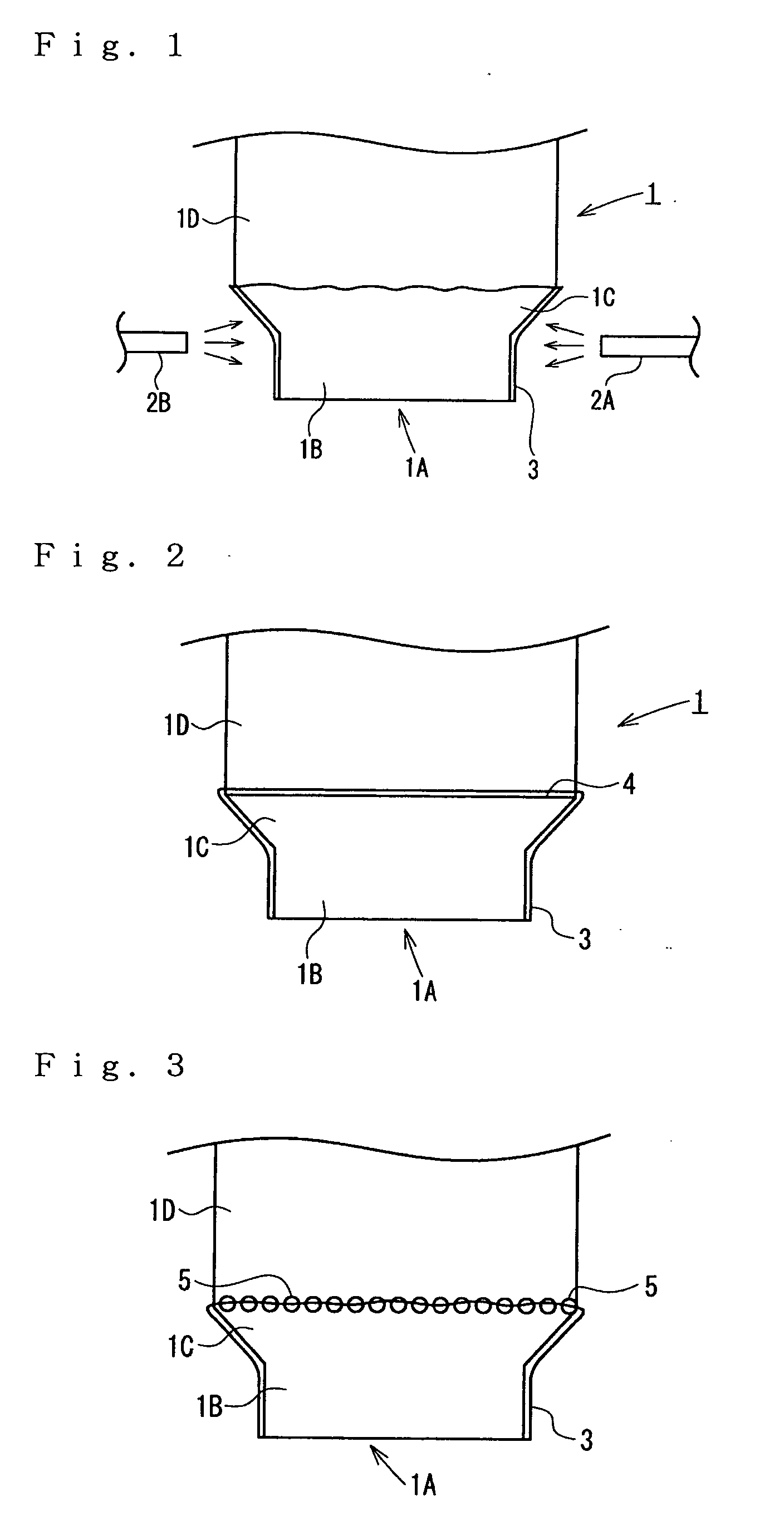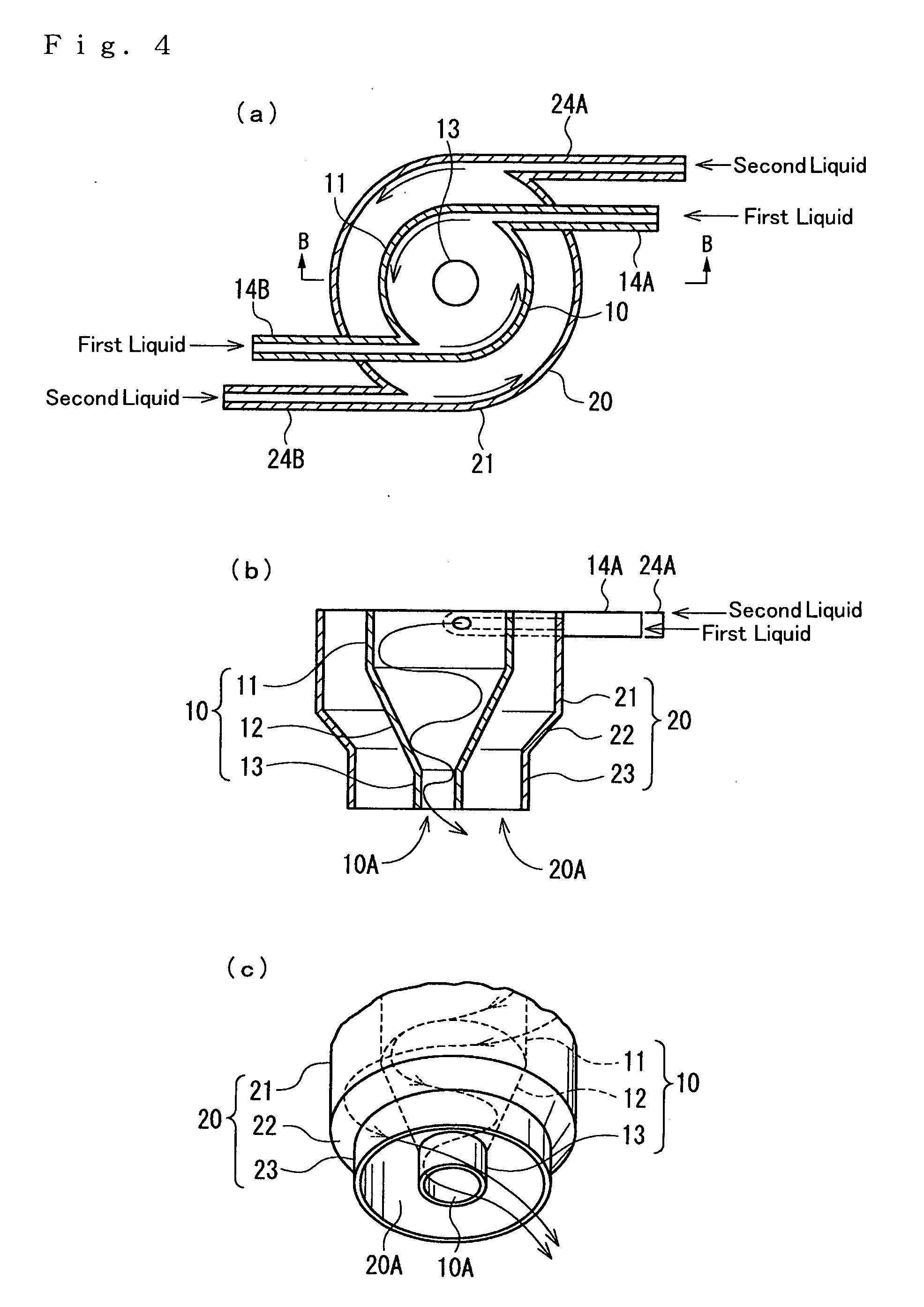Absorbent composite and method for producing same, asorbent article and nozzle
a technology of absorbent polymer and asorbent gel, which is applied in the field of absorbent composites, can solve the problems of absorbent material warping, absorbent gel dropping off from the substrate, and part of the absorbent polymer may locally concentrate, and achieves the effects of high absorbent speed, suitable softness, and large absorption
- Summary
- Abstract
- Description
- Claims
- Application Information
AI Technical Summary
Benefits of technology
Problems solved by technology
Method used
Image
Examples
example 1
Preparation of Starting Materials
[0289]573 g of aqueous 48.5 wt. % sodium hydroxide solution, 64 g of water, 1.5 g of a crosslinking agent (N,N′-methylenebisacrylamide) and 50 g of aqueous 30 wt. % hydrogen peroxide solution were added to 1250 g of aqueous 80 wt. % acrylic acid solution to prepare a solution A1. The monomer concentration in the solution A1 was 60% by weight, and the degree of neutralization of the solution was 50 mol %.
[0290]573 g of aqueous 48.5 wt. % sodium hydroxide solution, 99 g of water, 1.5 g of a crosslinking agent (N,N′-methylenebisacrylamide) and 15 g of L-ascorbic acid were added to 1250 g of aqueous 80 wt. % acrylic acid solution to prepare a solution B1. The monomer concentration in the solution B1 and the degree of neutralization of the solution were the same as those of the solution A1.
(Substrate)
[0291]An air-through polyester nonwoven fabric comprising linear fibers having a fiber diameter of 6.7 dtex (linear diameter 25 μm), a mean fiber length of 2...
example 2
Preparation of Starting Materials
[0296]Solutions A2 and B2 were prepared in the same manner as that for the solutions A1 and B1, respectively, in Example 1, for which, however, the amount of the crosslinking agent used was changed to 0.75 g. Solutions A3 and B3 were prepared in the same manner as that for the solutions A1 and B1, respectively, in Example 1, for which, however, the amount of the crosslinking agent used was changed to 3.00 g. The monomer concentration in the solutions A2, A3, B2 and B3, and the degree of neutralization of the solutions were all the same as those of the solutions A1 and B1.
[0297]In place of the solution A1 and the solution B1, the solution A2 and the solution B2 were polymerized in the same manner as in Example 1. In this, the same substrate and the same nozzle unit as in Example 1 were used. However, the substrate was put on a belt horizontally traveling at 0.1 m / min by belt conveyor. The diameter of the droplets under polymerization w...
example 3
[0301]Using the same material solutions and the same substrate as those in Example 2, using the nozzle in the manner mentioned below for polymerization, and effecting the surface-crosslinking treatment as in Example 1, an absorbent composite was produced. Two nozzle units of FIG. 14 were prepared, and they were disposed in parallel to each other on the same face, as spaced by 10 cm in terms of the distance between the center axes of the units. Through one nozzle unit (first nozzle unit), the solutions A2 and the solution B2 were mixed, and at the same time, through the other nozzle unit (second nozzle unit), the solution A3 and the solution B3 were mixed. The droplets were brought into contact with the substrate horizontally traveling at 2 m below the meeting point of the two solutions. The traveling direction of the substrate was vertical to the supply duct of each nozzle unit; and the substrate traveled horizontally first below the first nozzle unit and then below the second nozzl...
PUM
| Property | Measurement | Unit |
|---|---|---|
| particle size | aaaaa | aaaaa |
| thickness | aaaaa | aaaaa |
| size | aaaaa | aaaaa |
Abstract
Description
Claims
Application Information
 Login to View More
Login to View More - R&D
- Intellectual Property
- Life Sciences
- Materials
- Tech Scout
- Unparalleled Data Quality
- Higher Quality Content
- 60% Fewer Hallucinations
Browse by: Latest US Patents, China's latest patents, Technical Efficacy Thesaurus, Application Domain, Technology Topic, Popular Technical Reports.
© 2025 PatSnap. All rights reserved.Legal|Privacy policy|Modern Slavery Act Transparency Statement|Sitemap|About US| Contact US: help@patsnap.com



